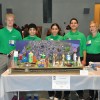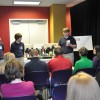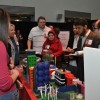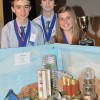Nat'l Engineers' Week Presents The Future City Competition
Video
Middle School Kids Design Sustainable Cities to Help Those in Distress
At 7:30 a.m. on a winter Saturday, a time when most kids are still sleeping, professional-looking seventh and eighth graders were already buzzing around pushing carts that were loaded with table-sized futuristic city models and getting them into place for a day-long judging process. The projects that these students were rushing about represent hours of thinking, designing, researching, and collaborating with mentors and classmates to create: An Affordable Living Space For People Who Have Lost Their Home Due to a Disaster or Financial Emergency.
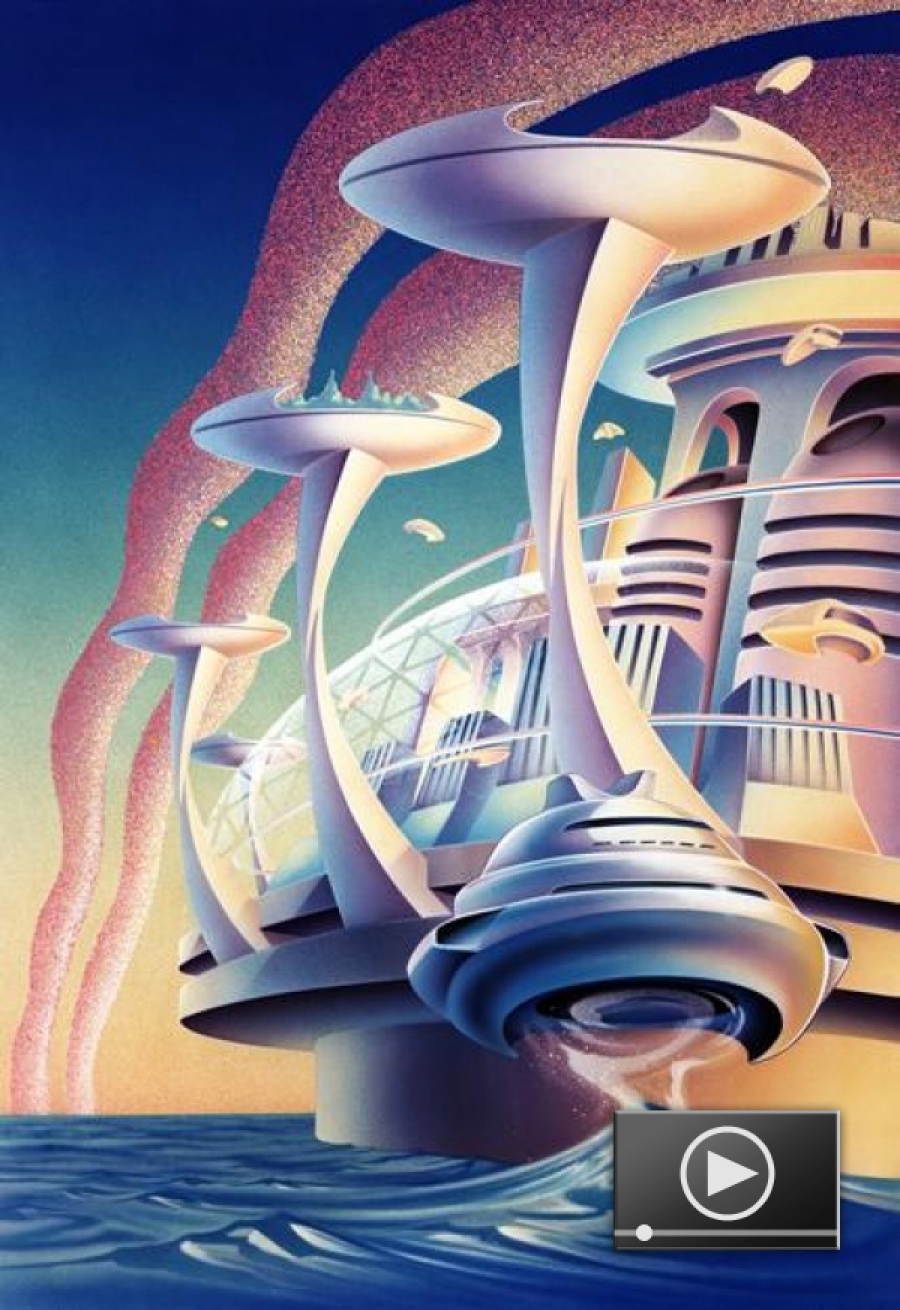 2010 Future City Competition - Ohio Region
2010 Future City Competition - Ohio Region
"We invented a city for Sudanese refugees," says the Bexley Middle School Team from Bexley, Ohio, whose school ultimately won both the regional and national competitions last year including regionals again this year, "Our homes are designed as safe havens because we believe the people there need to feel safety above all else."
In an exciting, family-packed atmosphere, The 2010 Ohio Regional Future City Competition (FCC) was held on January 16th at COSI, the Center of Science and Industry, in Columbus, Ohio. The National Engineers' Week Foundation, developed 15 years ago, is the largest engineering educational program for middle school students in the U.S. According to the FCC, the competition fosters engineering skills, such as: teamwork, communication and problem solving skills; provides interaction among students, teachers, and engineer mentors; informs the community about the multi-disciplines within the engineering profession; and inspires students to explore futuristic concepts and careers in engineering. "I was blown away with the innovative solutions these kids had for sustainable living," says Olivia Miller, Structural Engineer for American Electric Power who volunteered as one of the special award judges for "Best Use of Energy." (See the list of special awards judging categories and Ohio regional winners.)
Top Five Winners Overall
- First Place – Bexley Middle School, Bexley
- Second Place – St. Vincent de Paul, Mt. Vernon
- Third Place – Immaculate Conception Academy, Cincinnati
- Fourth Place – St. Ambrose Middle School, Brunswick (first year participant)
- Fifth Place – Morton Middle School, Vandalia (first year participant)
Special award winners are as follows:
Best Architectural Model - sponsored by American Institute of Architects Columbus Chapter
- First Place – Bexley Middle School, Bexley
- Honorable Mention - St Vincent de Paul, Mt. Vernon
Best Computer City Design— sponsored by M•E Companies
- First Place – Bexley Middle School, Bexley
- Honorable Mention – New Richmond Middle School, New Richmond
Best Essay— sponsored by Society of Marketing Professionals, Cincinnati Chapter
- First Place – Bexley Middle School, Bexley
- Honorable Mention – St Vincent de Paul, Mt. Vernon
Best Infrastructure— sponsored by American Society of Civil Engineers
- First Place – Lakewood Middle School, Hebron
- Honorable Mention – Batavia Middle School, Batavia
Best Moving Part— sponsored by Worthington AM Rotary Club
- First Place - Batavia Middle School, Batavia
- Honorable Mention – St Vincent de Paul, Mt. Vernon
Best Use of Ceramics— sponsored by Allied Mineral Products
- First Place – Anna Middle School, Anna
- Honorable Mention – St Vincent de Paul, Mt. Vernon
Best Use of Energy— sponsored by Ohio Department of Development, Office of Energy Efficiency
- First Place – Batavia Middle School, Batavia
- Honorable Mention – St Vincent de Paul, Mt. Vernon
Best Use of Recreation— sponsored by Worthington AM Rotary Club
- First Place – Batavia Middle School, Batavia
- Honorable Mention – Immaculate Conception Academy, Cincinnati
Best Use of Recycled Materials— sponsored by Hull & Associates, Inc.
- First Place – Batavia Middle School, Batavia
- Honorable Mention – Bexley Middle School, Bexley
Best Use of Transportation— sponsored by Ford Motor Company Fund
- First Place – St Vincent de Paul, Mt. Vernon
- Honorable Mention – Morton Middle School, Vandalia
Best Use of Water Resources Engineering— sponsored by Sam Chebaro Memorial- Ohio Environmental Protection Agency, Office of Environmental Education
- First Place – St Vincent de Paul, Mt. Vernon
- Honorable Mention – Bexley Middle School, Bexley
Most Economic Project— sponsored by Gianola Financial Planning
- First Place – St. Vincent de Paul, Mt. Vernon
- Honorable Mention – Dayton Islamic School, Dayton
Most Environmentally Friendly— sponsored by Stantec Consulting Services, Inc.
- First Place – Batavia Middle School, Batavia
- Honorable Mention – Immaculate Conception Academy, Cincinnati
Rookie of the Year— sponsored by Collector Wells, International
- First Place – St. Ambrose, Brunswick
- Honorable Mention - Morton Middle School, Vandalia
People’s Choice— sponsored by Battelle Memorial Institute
- First Place – Batavia Middle School, Batavia
- Honorable Mention – Immaculate Conception Academy, Cincinnati
The Assignment
Each student-led team, comprised of three seventh and eighth graders, one teacher, and one design professional, began the process by designing a model of their city digitally with SimCity 4 Deluxe software, provided by Electronic Arts. Then the team built a physical model of their city using recycled materials, with the cost totaling no more than 100 dollars. Finally, the students wrote two research essays: one that described their design, and the other about the key features in their city.
"It's neat to see them thinking outside the box"
It was hard to miss the aura of confidence that emanated from these sophisticated middle school participants as they took turns presenting their innovative and sustainable building, energy, and infrastructural concepts to teams of industry professionals. This type of competition is an important educational tool because we depend on the brilliance of the next generation of engineers. The sooner they are exposed to their future challenges, the better.
"I really liked hearing the innovative ideas that the participants came up with. This year, one group had aerodynamic grocery carts that would follow you home so you could unload your groceries, and then return to the store on their own. The grocery cart ran on high efficiency fuel or renewable energy of some sort and its function was to promote people to walk or ride their bicycle to the store instead of using a motor vehicle just so they could transport their groceries. It's neat to see them thinking outside the box," says Barbara Jordan, PE, SI, Team Leader, Traffic and Roadway Engineer for Woolpert of Columbus, Ohio.
Competition Educational and Design Themes
Many project decisions were informed by lessons learned from natural disasters, such as the flooding of New Orleans during Hurricane Katrina in 2005, and the much worse damage that has occurred from the recent earthquakes in Haiti. The students were asked to keep low cost technologies and infrastructure in mind, so they could conceive of their project as a source for building solutions for people who are in economic distress and/or misplaced from their homes.
In tackling such an important and serious design problem, the competition encourages meaningful collaboration amongst a whole class full of students. In the end, one set of three students are selected to head off to the official judging days for the Ohio Regional Competition. Talking to several groups of students, this theme rung true amongst many of the student groups.
"We are here today presenting our city, but what you see here is really a compilation of efforts from our entire class,"
- The Smith Middle School Team from Dayton, Ohio.
Gorgeous and intriguing, the physical models commanded much of the attention that morning. Altogether, they were creativity at its best and ingenuity on the edge, full of decorative colors and sparkling pieces of "trash." After all, the models were to be comprised of cheaply harvested recycled materials; often classroom parents donated the items used. Judges made comments such as: "I love seeing the Christmas tree ornaments;" "Wow, that looks cool;" and, their curiosity piqued, "What is that?" Most would agree that for the adults walking through the exhibits, being able to see firsthand these creative, innovative, and colorful projects, and meeting the well-composed young scholars who presented them, was like a breath of fresh air. "We leave the FCC each year inspired by these kids. I am so proud of them," says Miller.
Judges Make Their Selections
For nearly the entire day, students follow a strict judging schedule. Each team gives a timed presentation of their city before a panel of judges, and answers questions from the judges related to their designs. They also chat with, and field questions from, the special awards judges in the main exhibition hall. All of the judges are carefully selected based on either their professional or student careers. Five special guests this year were Ohio State University Engineering students who were themselves a part of the FCC when they were in middle school. At the end of the day, one team wins and makes plans to compete nationally in Washington D.C. "Last year marked the first time any one region has won the national competition two years in a row. We are hoping to beat that record this year with three years in a row," says Lisa M. Huelskamp, PhD, National Engineers Week Future City Coordinator for the Ohio Region.
It was evident that each team focused its energy a little differently in addressing the competition's design problem. Even though not every team can earn titles, it was clear that all of the students involved had become enthralled with the new technologies they had discovered. Some of the ideas of note (whether because they were scholarly, radical, or maybe even a little crazy!) were as follows:
- shooting trash from earth to Jupiter in a rocket, hoping most of it would burn up in Jupiter's atmosphere during its journey;
- making Polymer Electrolyte Membrane (PEM) fuel cells to power the city's “Moving Part,” for which the students actually constructed a real fuel cell that separates hydrogen and oxygen elements through electrolysis;
- using the gases from decomposing trash to help rotate wind turbines above ground;
- building a city completely underwater or nearly completely underground;
- designing magnetically powered transit systems;
- conceiving of teleporters to transfer people and items to various parts of the city;
- installing wave turbines that capture energy from waves;
- conceptualizing various types of solar collectors, including ones with paints and fabrics along with reflectors of all sorts; and
- utilizing pressure from pedestrians and vehicles to compress a stress on the pavement that could generate energy for the street lights.
An Abundant Measure of Success
How can one even begin to measure the magnitude and depth of learning that the Future City Competition has provided for middle schoolers nationwide? Mark Farrell, Director of Engineering at Questline, who is a lead organizer of the event and has been a faithful volunteer for 15 years, says, “This is the first year when we can really see the fruits of our efforts. We have five judges here today who were all part of the FCC while they were in middle school. Each of them are now students in the School of Engineering at The Ohio State University."
So the Future City Competition has been successfully measured. "The FCC did play an important role in why I chose to study engineering. As a junior high student, the FCC opened up my eyes to a world of applied mathematics and science that gave me a career goal perspective as a young person. I am very happy to be an engineering student at OSU," says Jason Ezzell, a returning student who participated in the FCC as a middle schooler and is now an engineering student at The Ohio State University. The teachers and professionals who mentor the children also see many benefits and exhibit genuine excitement as participants each year.
"We need more engineers in the U.S. Each year, China and India turn out 200-300 thousand engineers while we only produce about 40 thousand at home,"
says Michealangelo Pedicini, engineering mentor for the Immaculate Conception Academy from Cincinnati, Ohio.
Aside from the measurable element of educational success, and despite whether or not a given group was a "winner," each child could tell the judges with confidence what they had learned throughout the process from designing, building, writing, and public speaking. Not only that, but we could also tell they all had fun during the entire process. "I really liked seeing the kids dress up to complement their Future Cities. One group who had built an underwater city wore flippers and snorkel masks. Another, who had designed an underground city due to the surface of the earth being destroyed by a hazardous explosion, wore hazmat suits and laboratory safety goggles. It's fun to see the kids get into the creative mindset," says Jordan.
As a judge myself for "The Best Moving Part," I noticed that each student from each team could field my questions with a studied elegance. I was considerably impressed at the wealth of knowledge and research they brought to the table that Saturday morning. It is no wonder the Future City Competition has teachers and design professionals who plan to return as volunteers a year in advance. Hopefully this competition takes us one step closer to saving our natural resources from unnecessary depletion. After all, "These students are the future. It makes sense for them to work on solutions for our projected energy needs because they will be the ones to live during a new era dominated by alternative energies," says Miller.
If you are a student, teacher, professional mentor, parent, or judge and would like to share your comments and even photographs, please send them to stephanie.aurora.lewis@buildipedia.com so that we can add your content to our article. Thank you!

Stephanie Aurora Lewis
Stephanie, an NCARB registered architect and LEED AP, draws upon her studies in architectural history and theory from Sarah Lawrence College and her master’s degree in architecture from The Ohio State University. Providing copy for publications and performing marketing work for the construction industry, Stephanie works as an independent freelancer from Columbus, Ohio.
Website: greengaloredesigner.blogspot.com/
